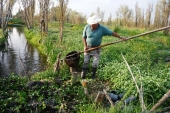









Idle dreamer




"You must be the change you want to see in the world." "First they ignore you, then they laugh at you, then they fight you, then you win." --Mahatma Gandhi
"Preach the Gospel always, and if necessary, use words." --Francis of Assisi.
"Family farms work when the whole family works the farm." -- Adam Klaus




1. my projects
 1
1




Brenda
Bloom where you are planted.
http://restfultrailsfoodforestgarden.blogspot.com/

























Alder Burns wrote:If you have plans for fruit or other trees, and even bush fruits, whether in an orchard or scattered about, consider starting areas of garden where the trees, etc. are going to go and planting the trees among your vegetables. You will have several years to grow there, and can always be slowly adding more shade-tolerant perennials up under the trees as they grow. The trees will benefit hugely from the soil preparation, water and attention given primarily to the annuals. When the area is mostly shaded, you will have succeeded the area to perennials or perhaps groundcover or pasture, and moved the annual garden elsewhere. This is one way to utilize succession and stacking functions. You can keep doing this until all of your perennial plants are established and by then you will have a much better idea of where and how big your permanent annual garden area will need to be....




Seed the Mind, Harvest Ideas.
http://farmwhisperer.com














|
a little bird told me about this little ad:
The new kickstarter is now live!
https://www.kickstarter.com/projects/paulwheaton/garden-cards
|






